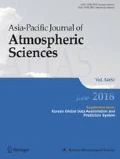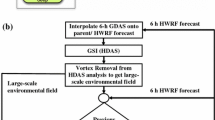Abstract
In this study, the impact of various types of observations on the track forecast of Tropical Cyclone (TC) Jangmi (200815) is examined by using the Weather Research and Forecasting (WRF) model and the corresponding three-dimensional variational (3DVAR) data assimilation system. TC Jangmi is a recurving typhoon that is observed as part of the THORPEX Pacific Asian Regional Campaign (T-PARC). Conventional observations from the Korea Meteorological Administration (KMA) and targeted dropsonde observations from the Dropwindsonde Observations for Typhoon Surveillance near the Taiwan Region (DOTSTAR) were used for a series of observation system experiments (OSEs). We found that the assimilation of observations in oceanic areas is important to analyze environmental flows (such as the North Pacific high) and to predict the recurvature of TC Jangmi. The assimilation of targeted dropsonde observations (DROP) results in a significant impact on the track forecast. Observations of ocean surface winds (QSCAT) and satellite temperature soundings (SATEM) also contribute positively to the track forecast, especially two- to three-day forecasts. The impact of sensitivity guidance such as real-time singular vectors (SVs) was evaluated in additional experiments.
Similar content being viewed by others
References
Aberson, S. D., 2002: Two years of operational hurricane synoptic surveillance. Wea. Forecasting, 17, 1101–1110.
_____, 2003: Targeted observations to improve operational tropical cyclone track forecast guidance. Mon. Wea. Rev., 131, 1613–1628.
_____, 2008: Large forecast degradations due to synoptic surveillance during the 2004 and 2005 hurricane seasons. Mon. Wea. Rev., 136, 3138–3150.
_____, and J. L. Franklin, 1999: Impact on hurricane track and intensity forecasts of GPS dropwindsonde observations from the first-season flights of the NOAA Gulfstream-IV jet aircraft. Bull. Amer. Meteor. Soc., 80, 421–427.
_____, and B. J. Etherton, 2006: Targeting and data assimilation studies during Hurricane Humberto (2001). J. Atmos. Sci., 63, 175–186.
Anthes, R. A., and Coauthors, 2008: The COSMIC/FORMOSAT-3 Mission: Early results. Bull. Amer. Meteor. Soc., 89, 313–333.
Burpee, R. W., S. D. Aberson, J. L. Franklin, S. J. Lord, and R. E. Tuleya, 1996: The impact of omega dropwindsondes on operational hurricane track forecast models. Bull. Amer. Meteor. Soc., 77, 925–933.
Barker, D., W. Huang, T.-R. Guo, and A. Bourgeois, 2003: A threedimensional variational (3DVAR) data assimilation system for use with MM5. NCAR Tech. Note. NCAR/TN-453 + STR, 68 pp.
_____, ______, ______, ______, and Q. N. Xiao, 2004: A three-dimensional variational data assimilation system for MM5: Implementation and initial results. Mon. Wea. Rev., 132, 897–914.
Buizza, R., C. Cardinali, G. Kelly, and J.-N. Thepaut, 2007: The value of observations. II: the value of observations located in singular-vector-based target areas. Quart. J. Roy. Meteor. Soc., 133, 1817–1832.
Chen, F., and J. Dudhia, 2001: Coupling an advanced land surface-hydrology model with the Penn State-NCAR MM5 modeling system. Part I: Model implementation and sensitivity. Mon. Wea. Rev., 129, 569–585.
Chou, K.-H., and C.-C. Wu, 2008: Development of the typhoon initialization in a mesoscale model — Combination of the bogused vortex with the dropwindsonde data in DOTSTAR. Mon. Wea. Rev., 136, 865–879.
_____, ______, P.-H. Lin, and S. Majumdar, 2010: Validation of QuikSCAT wind vectors by dropwindsonde data from Dropwindsonde Observations for Typhoon Surveillance Near the Taiwan Region (DOTSTAR). J. Geophys. Res., 115, D02109, doi:10.1029/2009-JD012131.
Dudhia, J., 1989: Numerical study of convection observed during the winter monsoon experiment using a mesoscale two-dimensional model. J. Atmos. Sci., 46, 3077–3107.
Elsberry, R. L., and P. A. Harr, 2008: Tropical cyclone structure (TCS08) field experiment science basis, observational platforms, and strategy. Asia-Pacific J. Atmos. Sci., 44, 209–231.
Grell, G. A., 1993: Prognostic evaluation of assumptions used by cumulus parameterizations. Mon. Wea. Rev., 121, 764–787.
Hong, S.-Y., and J.-O. Lim, 2006: The WRF single-moment 6-class microphysics scheme (WSM6). J. Korean Meteor. Soc., 42, 129–151.
_____, Y. Noh, and J. Dudhia, 2006: A new vertical diffusion package with an explicit treatment of entrainment processes. Mon. Wea. Rev., 134, 2318–2341.
Huang, C.-Y., Y.-H. Kuo, S.-H. Chen, and F. Vandenberghe, 2005: Improvements in typhoon forecast with assimilated GPS occultation refractivity. Wea. Forecasting., 20, 931–953.
Kain, J. S., 2004: The Kain-Fritsch convective parameterization scheme: An update. J. Appl. Meteorol., 43, 170–181.
Kim, H. M., and M. Morgan, 2002: Dependence of singular vector structure and evolution on the choice of norm. J. Atmos. Sci., 59, 3099–3116.
_____, and B.-J. Jung, 2009a: Singular vector structure and evolution of a recurving tropical cyclone. Mon. Wea. Rev., 137, 505–524.
_____, and ______, 2009b: Influence of moist physics and norms on singular vectors for a tropical cyclone. Mon. Wea. Rev., 137, 525–543.
_____, ______, Y.-H. Kim, and H.-S. Lee, 2008: Adaptive observation quidance applied to Typhoon Rusa: Implications for THORPEX-PARC 2008. Asia-Pacific J. Atmos. Sci., 44, 297–312.
Kurihara, Y., M. A. Bender, R. E. Tuleya, and R. J. Ross, 1995: Improvements in the GFDL hurricane prediction system. Mon. Wea. Rev., 121, 2030–2045.
Kwon, H. J., S.-H. Won, M.-H. Ahn, A.-S. Suh, and H.-S. Chung, 2002: GFDL-Type Typhoon Initialization in MM5. Mon. Wea. Rev., 130, 2966–2974.
Langland, R. H., C. Velden, P. M. Pauley, and H. Berger, 2009: Impact of Satellite-Derived Rapid-Scan Wind Observations on Numerical Model Forecasts of Hurricane Katrina. Mon. Wea. Rev., 137, 1615–1622.
Majumdar, S. J., S. D. Aberson, C. H. Bishop, R. Buizza, M. S. Peng, and C. A. Reynolds, 2006: A comparison of adaptive observing guidance for Atlantic tropical cyclones. Mon. Wea. Rev., 134, 2354–2372.
Mlawer, E. J., S. J. Taubman, P. D. Brown, M. J. Iacono, and S. A. Clough, 1997: Radiative transfer for inhomogeneous atmospheres: RRTM, a validated correlated-k model for the longwave. J. Geophys. Res., 102, 16663–16682.
Palmer, T. N., R. Gelaro, J. Barkmeijer, and R. Buizza, 1998: Singular vectors, metrics, and adaptive observations. J. Atmos. Sci., 55, 633–653.
Parrish, D. F., and J. C. Derber, 1992: The National Meteorological Center’s Spectral Statistical Interpolation analysis system. Mon. Wea. Rev., 120, 1747–1763.
Pu, Z.-X., and S. A. Braun, 2001: Evaluation of bogus vortex techniques with four-dimensional variational data assimilation. Mon. Wea. Rev., 129, 2023–2039.
_____, X. Li, C. S. Velden, S. D. Aberson, and W. T. Lui, 2008: The impact of aircraft dropsonde and satellite wind data on numerical simulations of two landfalling tropical storms during the Tropical Cloud Systems and Processes Experiment. Wea. Forecasting., 23, 62–79.
Shapiro, M., and A. Thorpe, 2004: THORPEX International science plan, Version 3, 2 November 2004, WMO/TD No. 1246, WWRP/THORPEX No.2. [Available online at http://www.wmo.int/thorpex.]
Skamarock, W. C., J. B. Klemp, J. Dudhia, D. O. Gill, D. M. Barker, W. Wang, and J. G. Powers, 2005: A description of the Advanced Research WRF version 2. NCAR Tech. Note NCAR/TN-468+STR, 88 pp.
Velden, C., and Coauthors, 2005: Recent innovations in deriving tropospheric winds from meteorological satellites. Bull. Amer. Meteor. Soc., 86, 205–223.
Weissmann M., F. Harnisch, C.-C. Wu, P.-H. Lin, Y. Ohta, K. Yamashita, Y.-K. Kim, E.-H. Jeon, T. Nakazawa, and S. Aberson, 2010: The influence of dropsondes on typhoon track and mid-latitude forecasts. Mon. Wea. Rev., in press.
WMO, 2002: International core steering committee for THORPEX First session (ICSC-1) Final report, 15-16 October 2002. [Available online at http://www.wmo.int/thorpex.]
Wu, C.-C., and Coauthors, 2005: Dropwindsonde Observations for Typhoon Surveillance near the Taiwan Region (DOTSTAR): An Overview. Bull. Amer. Meteor. Soc., 86, 787–790.
_____, K.-H. Chou, Y. Wang, and Y.-H. Kuo, 2006: Tropical cyclone initialization and prediction based on four-dimensional variational data assimilation. J. Atmos. Sci., 63, 2383–2395.
_____, ______, P.-H. Lin, S. D. Aberson, M. S. Peng, and T. Nakazawa, 2007: The impact of dropwindsonde data on typhoon track forecasts in DOTSTAR. Wea. Forecasting., 22, 1157–1176.
_____, and Coauthors, 2009: Inter-comparison of Targeted Observation Guidance for Tropical Cyclones in the North western Pacific. Mon. Wea. Rev., 137, 2471–2492.
Xiao, Q., Y.-H. Kuo, Y. Zhang, D. M. Barker, and D.-J. Won, 2006: A tropical cyclone bogus data assimilation scheme in the MM5 3D-Var system and numerical experiments with Typhoon Rusa (2002) near landfall. J. Meteor. Soc. Japan., 84, 671–689.
_____, L. Chen, and X. Zhang, 2008: Evaluations of BDA Scheme using the Advanced Research WRF (ARW) Model. J. Appl. Meteor. Climatol., 48, 680–689.
Yamaguchi, M., T. Iriguchi, T. Nakazawa, and C.-C. Wu, 2009: An observing system experiment for Typhoon Conson (2004) using a singular vector method and DOTSTAR data. Mon. Wea. Rev., 137, 2801–2816.
Zou, X., and Q. Xiao, 2000: Studies on the initialization and simulation of a mature hurricane using a variational bogus data assimilation scheme. J. Atmos. Sci., 57, 836–860.
_____, F. Vandenberghe, M. Pondeca, and Y.-H. Kuo, 1997: Introduction to adjoint techniques and the MM5 adjoint modeling system. NCAR Tech. Note NCAR/TN-435STR, 110 pp.
Author information
Authors and Affiliations
Corresponding author
Rights and permissions
About this article
Cite this article
Jung, BJ., Kim, H.M., Kim, YH. et al. Observation system experiments for Typhoon Jangmi (200815) observed during T-PARC. Asia-Pacific J Atmos Sci 46, 305–316 (2010). https://doi.org/10.1007/s13143-010-1007-y
Received:
Revised:
Accepted:
Published:
Issue Date:
DOI: https://doi.org/10.1007/s13143-010-1007-y



